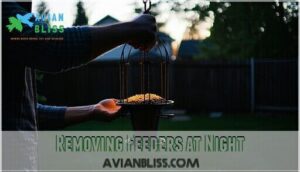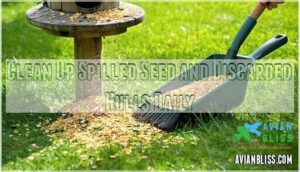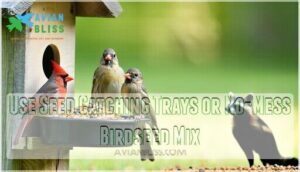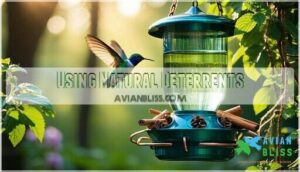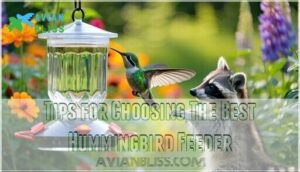This site is supported by our readers. We may earn a commission, at no cost to you, if you purchase through links.
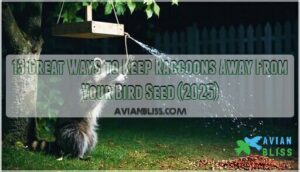
Install squirrel baffles on feeder poles, position feeders away from trees and structures, and use caged feeders that block larger animals.
Clean up spilled seed daily, since raccoons love easy ground meals.
Motion-activated sprinklers work great for nighttime deterrence. Try hot pepper birdseed blends – birds can’t taste the heat, but mammals sure can.
Remove feeders at night when raccoons are most active. Secure your trash cans and avoid leaving food scraps outside.
These masked bandits are clever, but the right combination of barriers and smart habits wins every time.
Table Of Contents
- Key Takeaways
- How to Keep Raccoons Out of Your Bird Feeders
- Using Raccoon-Proof Bird Feeders
- Creating a Clean Feeding Environment
- Using Natural Deterrents
- Considering Professional Pest Control or Trapping
- Tips for Choosing The Best Hummingbird Feeder
- Preventing Chipmunks From Raiding Bird Feeders
- Understanding Bird Behavior and Seed Waste
- Other Wildlife Challenges and Solutions
- Frequently Asked Questions (FAQs)
- Does Irish Spring soap keep raccoons away?
- What is the 5 7 9 rule for bird feeders?
- What animal is eating my bird seed at night?
- What will make raccoons stay away?
- What time of year are raccoons most active?
- Do raccoons remember where they found food before?
- How do I know if raccoons are visiting my feeders?
- Conclusion
Key Takeaways
- You’ll need to combine multiple strategies like squirrel baffles, motion-activated sprinklers, and hot pepper birdseed for effective raccoon deterrence – no single method works alone.
- Remove your feeders at night when raccoons are most active, and clean up spilled seed daily since these nocturnal bandits remember reliable food sources and will return repeatedly.
- Position feeders at least 10 feet from trees and structures, mount them 5-6 feet high on smooth metal poles, and install proper baffles to create physical barriers raccoons can’t overcome.
- Use caged feeders or no-mess seed blends to eliminate the scattered buffet that attracts raccoons, and secure your trash cans since unsecured garbage draws them closer to your bird feeding areas, utilizing hot pepper birdseed.
How to Keep Raccoons Out of Your Bird Feeders
Raccoons are clever nighttime raiders that can quickly empty your bird feeders if you don’t take the right steps to stop them.
You’ll need to use smart placement, daily maintenance, and physical barriers to protect your bird seed from these persistent bandits.
Refill Seed on a Daily Basis
Daily refilling keeps raccoons guessing and your yard peaceful.
Monitor your feathered friends’ eating patterns to determine proper seed quantity. Fill feeders with just enough for daytime consumption, leaving nothing for nighttime raiders.
This simple routine disrupts raccoon behavior while preventing spillage that attracts these nocturnal bandits.
- Peace of mind knowing your bird seed won’t fuel midnight raccoon parties
- Money saved from reduced seed waste and feeder damage
- Birds protected from aggressive raccoon competition at feeding stations
- Yard maintained without unsightly scattered hulls and debris everywhere
Make It Difficult for Raccoons to Climb Your Feeder Pole
Raccoon-proofing your feeder pole transforms your bird sanctuary into an impenetrable fortress. Install smooth pole guards or apply grease application around the base to create slippery surfaces.
Turn your backyard into a raccoon-proof bird paradise with smart barriers and daily maintenance routines.
Position your feeder height at least 5-6 feet high on metal pole material for maximum bird feeder protection.
- Slick metal cone baffle placement blocks climbing access
- Pole lubrication with grease creates raccoon deterrent surfaces
- Pepper gel application irritates sensitive paws
- Cylindrical pole guards provide complete raccoon proofing protection
Install a Squirrel Baffle
Installing the right squirrel baffle transforms your feeder pole into a raccoon-proof fortress.
You’ll need a baffle measuring 24 inches long and 8 inches wide for effective bird feeder protection.
Position this raccoon deterrent at least 44 inches off the ground, verifying proper installation height matches your pole diameter.
A key step is to verify correct baffle placement to prevent raccoons from bypassing it.
| Baffle Feature | Recommendation |
|---|---|
| Baffle Size | 24" x 8" minimum |
| Baffle Material | Steel or heavy-duty plastic |
| Installation Height | 44+ inches from ground |
| Pole Diameter | Match baffle to pole size |
| Baffle Maintenance | Monthly inspection needed |
Secure the baffle with hose clamps for stability.
Regular baffle maintenance prevents raccoon proofing failures and keeps your setup working effectively.
Check The Location of Your Feeders
Location matters more than you think in regards to raccoon control.
Position your bird feeders at least 10 feet from trees, fences, and structures that raccoons use as launching pads.
Ground clearance should be 5-6 feet minimum.
Choose smooth pole material over textured surfaces.
Eliminate hiding spots nearby.
Birds’ sharp vision allows them to spot feeders from afar, so visibility is key.
Smart feeder placement beats fancy gadgets every time, making it a crucial aspect of effective control.
Use a Repellent Spray
Anyone can apply animal repellent sprays around bird feeders to create an effective raccoon deterrence barrier.
These repellent spray products contain capsaicin or peppermint oil as repellent ingredients that irritate raccoons’ sensitive noses without compromising bird safety.
Apply the animal deterrent liberally to feeder poles and surrounding ground areas.
Application frequency typically requires respraying every 30-60 days or after heavy rainfall for maximum spray effectiveness.
While commercial options offer convenience, homemade pepper-water mixtures provide cost analysis benefits for budget-conscious homeowners.
Consistent use of these raccoon removal methods discourages nocturnal raiders from accessing your feeders permanently.
Combining sprays with ultrasonic sound devices enhances effectiveness.
Using Raccoon-Proof Bird Feeders
You can solve your raccoon problem by choosing feeders that make it impossible for these clever critters to reach the bird seed.
The right feeder design will keep raccoons frustrated while your feathered friends continue to eat in peace.
Caged Feeders
Caged feeders create an effective fortress around your bird seed that keeps raccoons at bay while allowing your feathered friends easy access.
These raccoonproof feeders feature protective wire mesh that blocks larger pests like raccoons and squirrels from reaching the food inside. These feeders are often called squirrel resistant feeders due to their similar effectiveness.
Here are three key factors when selecting the right caged feeder:
- Mesh Size – Choose gaps small enough to exclude raccoon paws (typically 1.5 inches or less) while ensuring Bird Accessibility for your target species
- Feeder Durability – Look for heavy-duty steel construction or vinyl-coated wire that withstands weather and determined wildlife
- Installation Ease – Consider mounting options and Cost Analysis to find the best value for effective raccoon removal from your feeding station
Hanging Feeders on a Wire With Soda Bottles
Suspending bird feeders on thin wire between two anchor points creates an effective raccoon prevention system. You’ll string 12-gauge galvanized wire tautly, then thread clean soda bottles horizontally along the suspension line.
These spinning plastic barriers prevent raccoons from maintaining their grip while crossing to reach your feeders. This raccoon defeat method has system limitations but offers excellent environmental impact compared to chemical solutions.
| Wire Specifications | Bottle Setup | Maintenance Tips |
|---|---|---|
| 12-gauge galvanized steel | 1-2 liter bottles work best | Check wire tension monthly |
| Maximum 1/2 inch diameter | Place bottles on both feeder sides | Clean bottles for slippery surface |
| Minimum 10 feet from climbing surfaces | Secure bottles tightly to wire | Replace damaged components immediately |
| Ceiling hanger wire recommended | Horizontal bottle placement essential | Inspect attachment points regularly |
| Use "S" hooks for height adjustment | Clean, dry bottles maintain effectiveness | Combine with other animal deterrents |
You can find various gauges available for this setup. The use of galvanized steel and proper bottle placement are crucial for the effectiveness of this deterrent system. Regular maintenance and inspection of the setup will ensure its continued success in preventing raccoon access to your bird feeders.
Removing Feeders at Night
Simple feeder storage can outsmart persistent raccoons who exploit their nocturnal habits to raid bird feeders. Since raccoons are most active at night, removing feeders eliminates their primary food source during peak foraging hours.
- Remove all feeders at sunset – Store them in secure locations like garages or sheds
- Establish a daily routine – Consistency prevents raccoon behavior patterns from forming
- Protect from seed spoilage – Indoor storage also prevents weather damage
This wildlife control method effectively breaks raccoons’ feeding cycles while accommodating nocturnal birds’ natural schedules.
Creating a Clean Feeding Environment
You’ll find that maintaining a spotless feeding area is your best defense against raccoons, who can’t resist messy buffets of scattered seeds and hulls.
Clean feeding practices remove the food sources that attract these clever nighttime visitors to your yard, which is a key aspect of complete concepts in yard maintenance.
Clean Up Spilled Seed and Discarded Hulls Daily
Since spilled seed acts like a raccoon dinner bell, you’ll need to clean up every fallen kernel and discarded hull daily.
This seed cleanup prevents pest attraction and eliminates the buffet that draws these nocturnal bandits.
Use a small broom or handheld vacuum as cleanup tools to remove debris thoroughly.
Regular maintenance disrupts raccoon behavior patterns while preventing soil contamination from decomposing hulls underneath your raccoonproof feeding station.
Use Seed Catching Trays or No-Mess Birdseed Mix
Adding a seed catching tray beneath feeders dramatically improves tray effectiveness by capturing dropped bird seed before it hits the ground.
These simple attachments reduce seed waste and eliminate the scattered mess that draws raccoons.
Consider a specialized seed catcher for ideal results.
No-mess birdseed mixes offer similar seed mix benefits since hulls are pre-removed. Both solutions enhance bird seed safety while lowering cleanup costs, making your feeding station less attractive to nighttime bandits with improved effectiveness.
Secure Trash Cans and Avoid Putting Out Food Scraps at Night
Beyond cleaning feeders, your trash cans can sabotage your raccoon-proofing efforts. These nocturnal bandits view unsecured garbage as an all-you-can-eat buffet, drawing them closer to your bird feeders.
Smart Trash Can Security and Food Scrap Management require strategic thinking. The goal is to outsmart these clever animals by managing waste effectively.
- Store trash cans in garages or use tight-fitting lids with bungee cords
- Freeze food scraps until pickup day to eliminate odors
- Rinse containers before recycling to reduce attractants
- Set bins curbside only on collection morning
Proper Nighttime Waste Control keeps raccoons focused elsewhere, which is crucial for protecting your bird feeders from these nocturnal bandits.
Using Natural Deterrents
You can protect your bird feeders using safe, natural methods that won’t harm birds or other wildlife.
These deterrents work by making your feeding area less appealing to raccoons while keeping it attractive to the birds you want to feed.
Hot Pepper Birdseed Blends
Hot pepper bird seed blends offer excellent capsaicin effectiveness against raccoons while maintaining complete bird tolerance.
Birds lack capsaicin receptors, so they’ll enjoy spicy seeds without any discomfort. Meanwhile, raccoons experience an intense burning sensation that sends them packing.
| Pepper Type | Capsaicin Level |
|---|---|
| Cayenne Powder | Medium Heat |
| Habanero Extract | High Heat |
| Ghost Pepper Blend | Extreme Heat |
| Jalapeño Flakes | Mild Heat |
| Commercial Hot Mix | Variable Heat |
Cost analysis shows hot pepper blends run 20-30% more than standard bird seed, but they’re worth every penny for bird seed safety and effective raccoon deterrence.
Night-Time Sprinklers or Motion-Activated Sprinklers
Motion activated sprinklers offer excellent wildlife deterrence against raccoons and other nocturnal animals.
Motion-activated sprinklers turn raccoons into reluctant water park visitors – one surprise splash and they’ll find a new buffet elsewhere.
These devices blast water when detecting movement, startling raccoons without causing harm. Proper sprinkler placement around feeders creates an effective barrier, while water conservation features guarantee minimal waste.
Most systems require basic sprinkler maintenance like battery checks and nozzle cleaning. Though initial costs vary, their cost effectiveness becomes apparent through reduced pest control needs.
Raccoon habituation rarely occurs since the unpredictable water spray maintains its surprise factor, making these sprinklers a reliable long-term solution.
Considering Professional Pest Control or Trapping
When home remedies and barriers don’t solve your raccoon problem, professional pest control services can provide effective trapping and removal solutions.
These experts understand local wildlife laws and use humane methods to relocate raccoons while preventing future infestations, which is a key aspect of their effective trapping and removal solutions.
Hiring Professional Pest Control?
Sometimes natural deterrents aren’t enough, and you’ll need professional pest control services.
Licensed experts bring specialized knowledge and humane raccoon control methods that protect both your property and wildlife.
Consider these factors when evaluating professional pest control:
- Cost Analysis – Compare quotes from multiple companies (typically $200-$500 for raccoon removal)
- Service Guarantees – Look for 100% satisfaction guarantees and transparent pricing
- Humane Practices – Verify they use ethical nuisance wildlife control techniques
- Long-Term Prevention – Confirm thorough damage assessment and ongoing protection strategies
These services are vital, as pest infestations impact ecosystems and can affect other wildlife.
Trapping as a Solution?
Trapping raccoons can be an effective last resort when other raccoon control methods fail. However, trapping legality varies by location, so check local wildlife regulations first.
Professional trappers understand humane trapping techniques and proper wildlife relocation procedures. Live cage traps offer the most humane raccoon control option.
| Trap Type | Best Use |
|---|---|
| Live Cage Traps | Humane raccoon management |
| Weight-Sensitive Traps | Avoiding non-target animals |
| 24-42 Inch Traps | Accommodating raccoon sizes |
Pros and Cons?
Before choosing trapping, weigh your options carefully.
The effectiveness debate continues among wildlife experts, while ethical considerations matter to many homeowners.
Key factors to examine:
- Cost analysis – Professional services run $200-500 versus $50 DIY deterrents
- Long-term impact – New raccoons often replace trapped ones
- Humane alternatives – Squirrel baffles and habitat modification work better
- Legal requirements – Many areas restrict raccoon relocation
- Success rates – Prevention beats removal every time
Tips for Choosing The Best Hummingbird Feeder
You’ll want to select a hummingbird feeder that deters raccoons while effectively attracting these tiny birds to your yard.
Choose feeders with narrow feeding ports and smooth surfaces that make it difficult for raccoons to access the nectar, while ensuring easy cleaning and maintenance for ideal hummingbird health.
Attracting Hummingbirds While Deterring Other Pests
While professional pest control handles stubborn raccoons, you can simultaneously create a hummingbird haven that keeps other pests away.
Smart hummingbird feeder design makes all the difference between nectar success and shared meals with unwanted visitors.
Choose feeders with narrow feeding ports that exclude bees while welcoming tiny hummingbird beaks. These hummingbird-safe deterrents work better than traditional raccoonproof feeders for nectar-based feeding:
- Install built-in ant moats or add vegetable oil barriers
- Select smooth glass surfaces that prevent bee gripping
- Position feeders away from flowering plants in shaded spots
- Use feeder guards for additional specific pest control protection
Proper Cleaning and Maintenance
Clean hummingbird feeders require different attention than regular bird feeders, but the same principles apply to keeping raccoons away.
Daily refills prevent fermentation that attracts unwanted visitors. Remove any seed spillage around the base since raccoons will investigate sweet nectar spills just like scattered birdseed.
Tray usage under hummingbird feeders catches drips that might draw raccoons with their keen sense of smell. Indoor storage overnight protects feeders from nocturnal raiders.
Area cleanliness around all feeders matters because raccoons remember productive feeding spots. Their washing habits mean they’ll return to water sources near feeders.
Maintaining proper feeder hygiene keeps both hummingbirds healthy and raccoons disinterested in your feeding stations, which is crucial for the overall health and well-being of the hummingbirds.
Preventing Chipmunks From Raiding Bird Feeders
While hummingbird feeders have their own challenges, chipmunks present a different set of problems for your regular bird feeders. Understanding chipmunk behavior helps you outsmart these persistent little raiders who’ll stuff their cheek pouches with your expensive bird seed.
These agile creatures easily scale feeder poles and squeeze through surprisingly small openings. Here’s how to keep them at bay:
- Install a squirrel baffle at least 18 inches below your feeder – chipmunks can only jump about 6 inches compared to squirrels’ 12-inch leaps
- Use squirrel proof feeder designs with weight-activated mechanisms that close when chipmunks land
- Apply natural repellents like cayenne pepper around the base – it won’t harm birds but deters mammals
Effective exclusion tactics involve mounting bird feeders on smooth metal poles positioned 7 feet from trees or structures. Consider habitat alteration by creating separate feeding stations with cheaper seeds away from your main feeders. These feeder modifications redirect chipmunk attention while protecting your premium bird seed investment.
Understanding Bird Behavior and Seed Waste
Everyone who feeds birds notices the mess, but understanding why birds scatter seed helps you tackle the problem effectively.
Bird feeding habits involve natural foraging behavior where birds sort through offerings to find preferred seeds.
Their beaks evolved to toss aside empty hulls and less desirable options while searching for high-quality nutrition.
Seed preference factors include size, nutritional content, and ease of cracking.
Birds instinctively reject seeds that don’t match their dietary needs, creating spilled seed around feeders.
This wasteful feeding signs actually represent normal behavior, not pickiness.
Seed dispersal aids in forest regeneration and ecosystem health.
Natural foraging impacts explain why birds continue sorting even with quality mixes.
Minimizing seed waste requires working with these behaviors rather than against them.
Choose no-mess blends without hulls, install seed-catching trays, and position feeders strategically.
Understanding these patterns helps prevent attracting raccoons to scattered seeds while maintaining successful bird feeding stations.
Other Wildlife Challenges and Solutions
Beyond raccoons, you’ll face several wildlife challenges at your bird feeders.
Squirrels represent the most persistent threat, requiring specialized squirrel deterrents like weight-activated perches and slippery pole guards.
Understanding bird behavior helps you recognize when seed waste attracts unwanted visitors.
Chipmunks dart quickly to snatch fallen seeds, while bears can destroy entire feeding stations in search of high-energy food.
Each species exhibits distinct animal behavior patterns that demand different solutions.
Bees swarm hummingbird feeders, wasps claim territory around suet, and mice gather beneath platforms overnight.
The raccoon diet overlaps with many other wildlife species, creating competition at feeding sites.
When multiple pest control methods fail, consider humane trapping for persistent offenders.
Professional wildlife services understand local regulations and animal behavior better than most homeowners.
Success requires patience, multiple deterrent strategies, and accepting that perfect wildlife control rarely exists in backyard feeding environments.
Frequently Asked Questions (FAQs)
Does Irish Spring soap keep raccoons away?
Don’t bet the farm on Irish Spring soap alone—it’s not a proven raccoon deterrent.
You’ll have better luck combining physical barriers, spicy birdseed, motion sprinklers, and nightly feeder removal for effective protection.
What is the 5 7 9 rule for bird feeders?
The 5-7-9 rule positions bird feeders 5 feet high, 7 feet from jumping points like trees or fences, and 9 feet from structures raccoons can climb to access your feeders safely.
What animal is eating my bird seed at night?
Raccoons are likely the culprits raiding your bird feeders at night. These nocturnal bandits love sunflower seeds and will climb poles, knock down feeders, and scatter seed everywhere while foraging.
What will make raccoons stay away?
Motion-activated sprinklers, hot pepper birdseed, and removing feeders overnight work best.
You’ll also want smooth metal poles with baffles, daily cleanup of spilled seeds, and secure trash storage to eliminate attractants.
What time of year are raccoons most active?
These masked bandits become particularly troublesome during spring and fall when they’re building fat reserves.
You’ll notice increased activity from March through May and September through November as they prepare for breeding season and winter survival.
Do raccoons remember where they found food before?
Yes, raccoons have excellent spatial memory and will return to reliable food sources repeatedly. Once they’ve discovered your bird feeders, they’ll likely come back nightly expecting another easy meal.
How do I know if raccoons are visiting my feeders?
Morning arrives, revealing telltale signs of midnight visitors.
Check for scattered seeds beneath feeders, muddy paw prints on poles, damaged equipment, and dark tubular droppings nearby.
Empty feeders that were full overnight confirm raccoon raids, which can be identified by these signs, including midnight visitors.
Conclusion
Watching raccoons scatter when motion sprinklers activate proves these strategies work.
Implementing multiple approaches from these 13 great ways to keep raccoons away from your bird seed creates layers of protection that outsmart these persistent visitors.
You’ll discover that combining physical barriers like baffles with behavioral changes such as nighttime feeder removal delivers the best results.
Remember, consistency matters most, and sticking with your chosen methods for several weeks will help you enjoy peaceful bird watching without unwanted masked guests raiding your feeders.
- https://jcswildlife.com/squirrel-stopper-deluxe-squirrel-proof-bird-feeder-pole-system-with-baffle/?ref=hVhUWmk6vKk1IL
- https://ahnow.org/
- https://homeguides.sfgate.com/raccoons-good-around-yard-52629.html
- https://birdsinthetree.com/how-to-install-a-baffle-on-a-bird-feeder/
- https://birdwatchingbuzz.com/13-great-ways-to-keep-raccoons-away-from-your-bird-seed/



